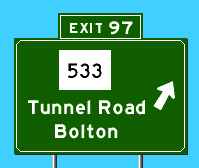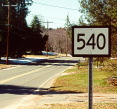SR 501 is a short freeway once planned to continue north to Farmington Avenue; called the "Trout Brook Connector," it would have been one of several spurs to I-84 in metropolitan Hartford.
To my knowledge, it has never (even in planning) been given a number other than 501. Presumably had it been built, a state route number under 400 would have been chosen for signage -- or, if the FHWA had approved it, an interstate highway number. Federal interstate highway funding fo I-84 at the time covered the highway itself, interchange ramps, and short connectors (about a mile or less); longer connectors were considered separate highways. In 1963, Rep. Emilio Daddario filed a request to add SR 501 to the interstate highway system, along with "a number of short stretches of highway in Connecticut." (The article doesn't list them.) The request was not granted.
Engineers started planning the expressway network around Hartford in the 1940s. By the early 1950s, the consensus had the major east-west expressway (now I-84) passing near Corbins Corner on the way to New Britain, well south of West Hartford Center. To serve that location, a Farmington Avenue Connector, paralleling Trout Brook Drive, was proposed. The portion of I-84 that turns directly south after exit 43, then veers west again near New Britain Avenue, is recognizable in planning maps from 1955.
In 1959, the planned route would have three partial interchanges (ramps to and from southbound) at Park Road, Boulevard, and Farmington Avenue.
On Sept. 3, 1965, SR 501 opened to traffic, along with a section of I-84 from Route 71 in West Hartford to Prospect Avenue in Hartford. Though the three-level interchange and short freeway were designed to extend further north, a lack of federal funds led the state to temporarily end SR 501 at Park Road.) The freeway was to be elevated and cross Farmington Avenue to end at Milton Street, at a cost of about $10 million.
In 1968, however, the state highway department said SR 501 could no longer be built exactly as planned because the "lane design and weave patterns" were no longer acceptable for modern traffic. West Hartford's mayor and state senator discussed other changes (now that SR 501 was no longer cast in stone), including shortening the route to south of Farmington Avenue.
In late 1970, open space concerns prompted officials to propose a lower profile roadway, at grade and ending at Farmington Avenue.
In 1975, the state planned to extend SR 501 to Farmington Avenue. Design was already complete, and construction expected to start soon, but the environmental impact statement status was "negative, pending."
At some time after that, the idea was abandoned.











 SignMaker mockup of SR 533 sign goof on I-86 circa 1982.
SignMaker mockup of SR 533 sign goof on I-86 circa 1982.

 Short-lived "sign goof" exposes SR 540 to motorists circa 2000.
Short-lived "sign goof" exposes SR 540 to motorists circa 2000.



